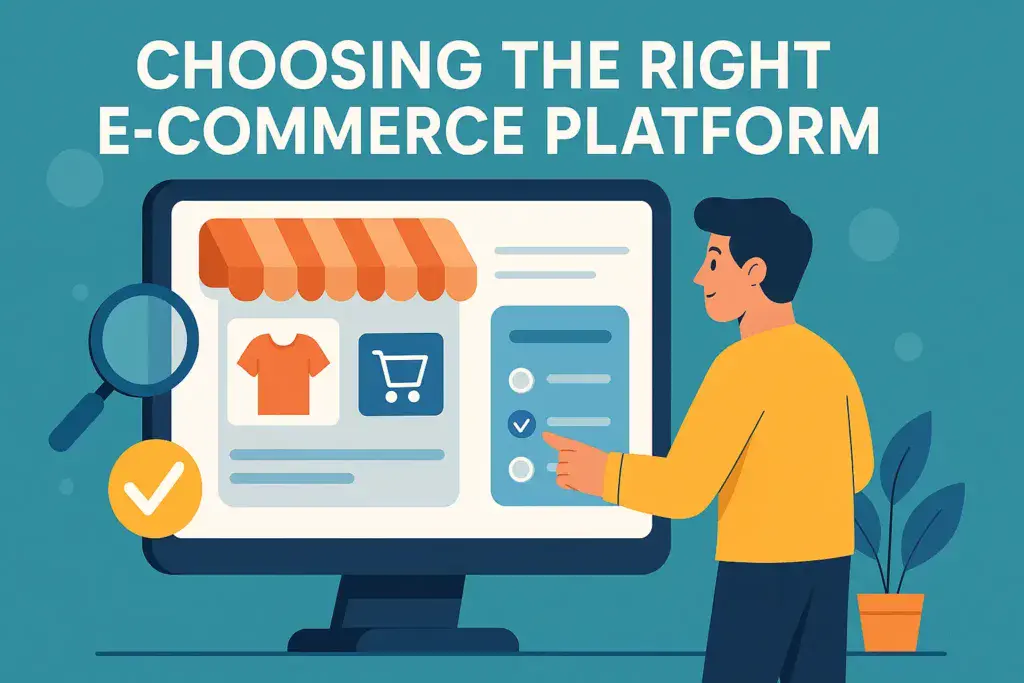
I. Introduction
In today’s digital age, establishing a robust online presence for your business is more crucial than ever. The rise of e-commerce has fundamentally transformed the shopping habits of consumers, making it essential for both entrepreneurs and established businesses to select the right e-commerce platform that aligns with their unique needs. With a multitude of options available, choosing the ideal platform can be daunting, especially for those who may not be well-versed in the technicalities of e-commerce.
An effective e-commerce platform serves as the backbone of your online store, influencing everything from user experience to operational efficiency and scalability. A well-chosen platform can streamline business processes, enhance customer engagement, and ultimately drive sales. Conversely, a poor choice can lead to frustrations, wasted resources, and missed opportunities.
This article aims to guide you through the process of selecting the right e-commerce platform. We will begin by helping you understand your specific business requirements, then evaluate various platforms based on their features, scalability, and customer support. Finally, we will provide insights into making an informed decision that takes into account both current needs and future growth. Whether you are a budding entrepreneur or a seasoned retailer, this comprehensive guide will equip you with the knowledge necessary to make the best choice for your e-commerce journey.
II. Understanding Your Business Requirements
Selecting the right e-commerce platform begins with a clear understanding of your business requirements. This foundational step will help identify essential features and functionalities for your online store, ensuring that the platform aligns with your overarching business goals. Here are key components to consider:
A. Identifying Your Target Audience
Understanding your target audience is crucial for tailoring your e-commerce solution to meet their needs and expectations. Start by analyzing demographic data, including age, gender, location, and purchasing behavior. Consider the type of shopping experience your audience prefers: do they favor mobile shopping or predominantly use desktop? This information will guide you in selecting a platform that offers necessary features, such as responsive design, mobile optimization, and personalized shopping experiences that resonate with your customers.
B. Defining Your Product Offerings
The nature of your product offerings will significantly influence your choice of a right e-commerce platform. Are you selling physical goods, digital products, or services? Each product type has distinct requirements regarding inventory management, shipping logistics, and payment processing. For example, if you plan to sell a wide variety of products, a platform with robust inventory management tools and multi-channel selling capabilities may be essential. Conversely, if your focus is on digital products, look for platforms that specialize in digital delivery and licensing management.
C. Assessing Your Budget and Resources
Budget considerations are a vital aspect of your decision-making process. E-commerce platforms can vary widely in cost, encompassing subscription fees, transaction charges, and additional expenses for plugins, themes, or third-party integrations. Evaluate your budget not only for initial setup but also for ongoing operational costs. Additionally, consider your internal resources: do you have a dedicated team for managing the e-commerce site, or will you need a platform that offers user-friendly tools for easier management? Understanding your financial and human resources will help you choose a platform that fits within your means while still meeting your operational needs.
By thoroughly understanding your business requirements, you can make informed choices that pave the way for a successful e-commerce venture.
III. Evaluating E-commerce Platforms
Once you have a clear understanding of your business requirements, the next step is to evaluate various e-commerce platforms to find the one that best aligns with your needs. This process involves a careful comparison of different options based on their features, scalability, and customer support.
A. Comparing Features and Functionalities
Each e-commerce platform offers a unique set of features and functionalities, making it crucial to compare them thoroughly. Identify the core features essential for your business. Common functionalities to consider include:
- Website Design and Customization Options: Assess the platform’s flexibility in design. Can you create a unique look that aligns with your brand identity?
- Payment Processing Capabilities: Check the variety of payment options available and whether they cater to your target audience’s preferences.
- Inventory Management Systems: Look for platforms that provide efficient ways to manage inventory, track stock levels, and automate reordering.
- Mobile Responsiveness: With an increasing number of consumers shopping on mobile devices, ensure the platform offers mobile-friendly designs or apps.
- SEO Features: Strong SEO capabilities can help improve your store’s visibility on search engines, driving organic traffic to your site.
By listing must-have features and comparing them across different platforms, you can narrow down your options to those that truly meet your business needs.
B. Looking Into Scalability Options
As your business grows, your e-commerce platform should grow with you. Scalability is a vital factor to consider during your evaluation. Consider the following aspects:
- Traffic Handling: Can the platform accommodate increased website traffic during peak seasons or sales events without compromising performance?
- Product Range Expansion: Will the platform support you in adding more products or categories as your inventory grows?
- Integration Capabilities: Look for platforms that can easily integrate with other tools and systems you may want to use in the future, such as CRM software, email marketing tools, or shipping services.
Choosing a scalable platform ensures you won’t have to migrate to a new system as your business expands, saving you time and resources in the long run.
C. Analyzing Customer Support and Service
Customer support is another critical aspect to evaluate when choosing an e-commerce platform. You want to ensure that help is readily available when you need it. Consider the following:
- Support Channels: Check what types of support are offered—email, live chat, phone support—and their availability. Is support available 24/7, or are there specific hours?
- Knowledge Base and Resources: Look for platforms that provide comprehensive documentation, tutorials, and community forums to help you troubleshoot issues independently.
- Response Times: Research user experiences regarding response times and the effectiveness of the support provided. Quick and helpful support can be invaluable, especially during the early stages of your business.
By thoroughly evaluating customer support options, you can ensure that you have the assistance needed to overcome challenges and make the most of your chosen platform.
In summary, evaluating e-commerce platforms is a critical step in your decision-making process. By comparing features, considering scalability options, and analyzing customer support, you can confidently select a platform that meets your current needs while being equipped for future growth.
IV. Making the Final Decision
Once you have gathered all the necessary information and evaluated your options, it’s time to make the final decision regarding which e-commerce platform best suits your needs. This step is crucial, as choosing the right platform can significantly impact your business’s success. Here are key considerations to guide you through this process.
A. Conducting Trials and Demos
Many e-commerce platforms offer free trials or demos, providing invaluable opportunities to test their features and functionalities firsthand. Take advantage of these trials to explore the platform’s user interface, ease of navigation, and overall performance. During this phase, consider how well the platform aligns with the business requirements identified earlier. Pay attention to the setup process and whether it allows you to integrate essential tools such as payment gateways, inventory management systems, and shipping solutions easily. A hands-on trial can reveal potential challenges that may not be apparent from marketing materials alone.
B. Reading User Reviews and Testimonials
User reviews and testimonials can offer critical insights into the real-world performance of an e-commerce platform. Look for feedback from businesses similar to yours to understand how the platform has met their needs. Pay particular attention to comments regarding customer support, reliability, and any hidden costs that may arise after the initial setup. Websites like G2, Trustpilot, or specialized e-commerce forums can be excellent resources for gathering this information. Additionally, reaching out to fellow entrepreneurs in your network can provide personal experiences that further inform your decision.
C. Considering Long-Term Growth Potential
While immediate needs are essential, it’s also crucial to consider the long-term growth potential of the e-commerce platform you choose. Will it be able to scale as your business grows? Evaluate whether the platform can accommodate increased traffic, additional product lines, or geographical expansion in the future. Look for features that support scalability, such as customizable options, third-party integrations, and advanced marketing tools. Selecting a platform that can evolve with your business will save you from the hassle and costs of migrating to a new system down the line.
By carefully conducting trials, reading user experiences, and considering scalability, you can make an informed decision that aligns with your business objectives and sets the stage for future success. This thoughtful approach will not only facilitate a smoother transition to your chosen e-commerce platform but also enhance overall operational efficiency in the long run.
V. Conclusion
Choosing the right e-commerce platform is a critical decision that can significantly affect the success and growth of your online business. By thoroughly understanding your specific business requirements, you can narrow down your options to platforms that best align with your goals and target audience. The evaluation process—comparing features, assessing scalability, and analyzing customer support—is essential to ensure that the platform you select will not only meet your current needs but also adapt as your business evolves.
Moreover, taking the time to conduct trials, read user reviews, and consider long-term growth potential will help you make a well-informed decision. Remember that the ideal platform balances functionality, ease of use, and cost-effectiveness while providing the tools necessary to create a seamless shopping experience for your customers.
Ultimately, investing effort into selecting the right e-commerce platform will lay the foundation for your business’s success. As the online retail landscape continues to evolve, a well-chosen platform can empower you to navigate challenges, seize opportunities, and foster lasting relationships with your customers. Embrace this journey with careful consideration and strategic planning, and you’ll be well on your way to building a thriving e-commerce presence.



